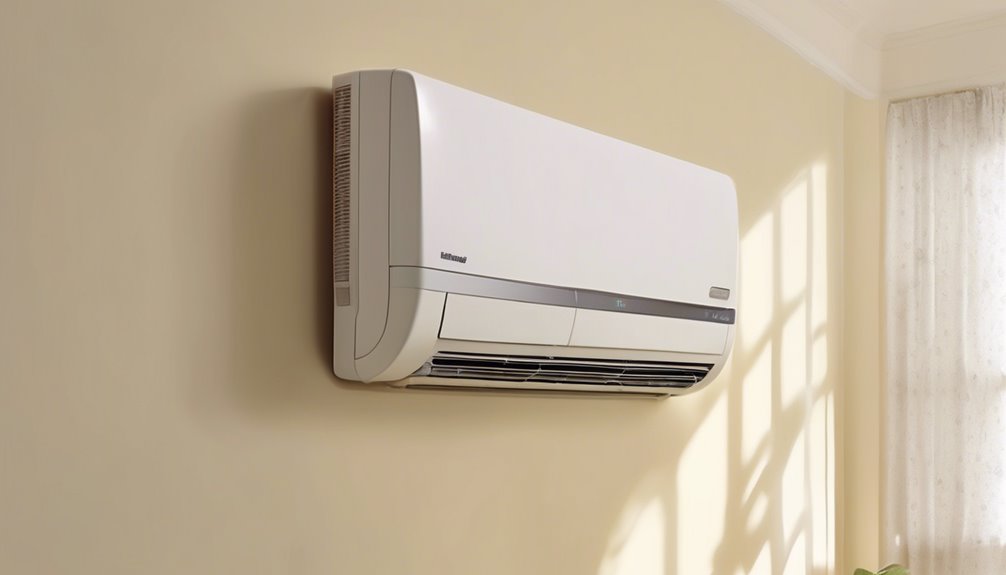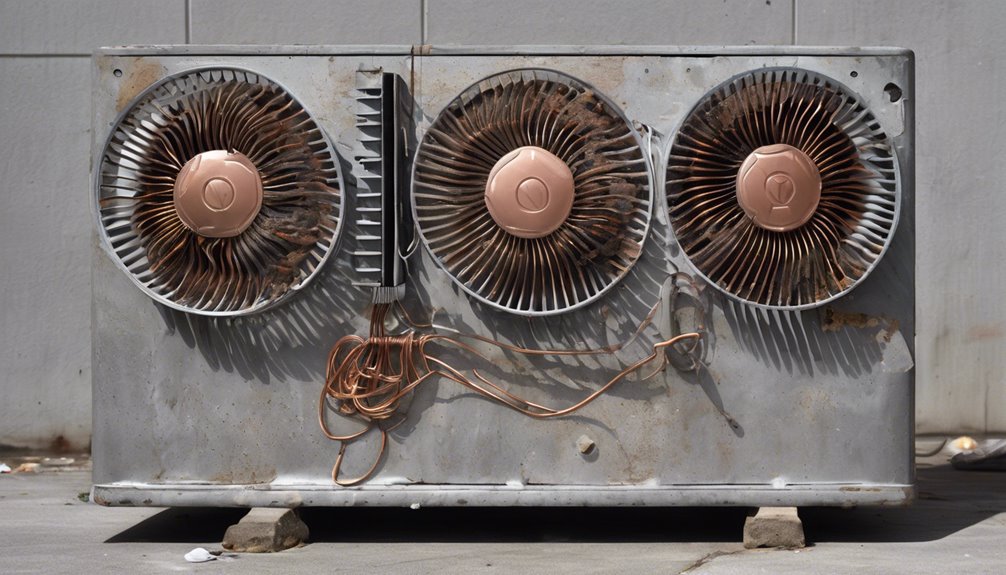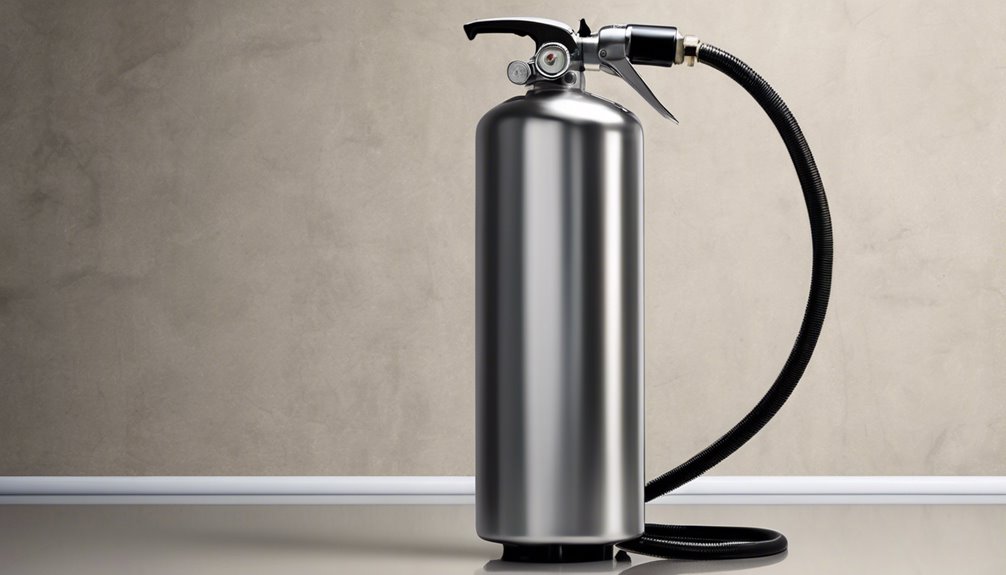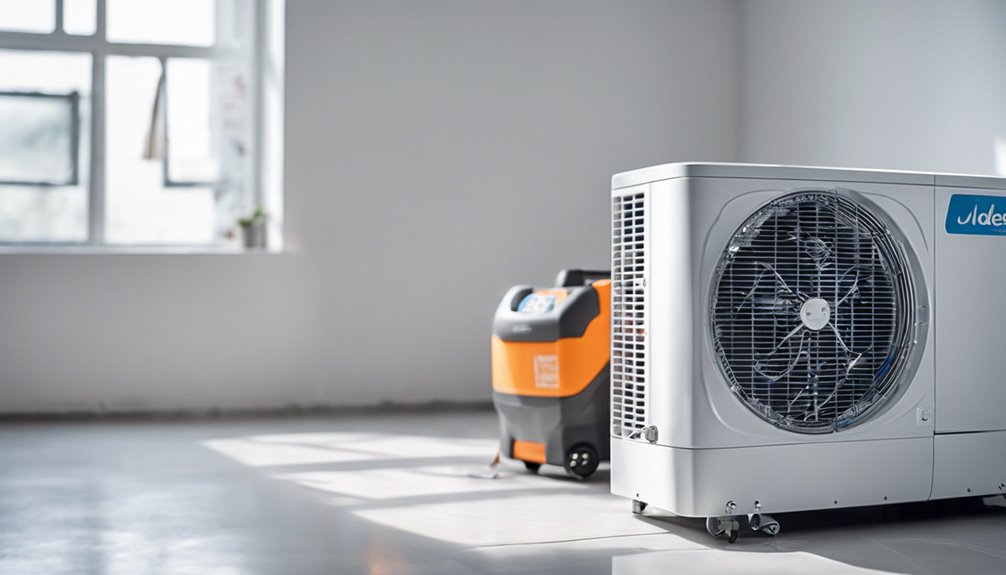When your split AC is running but not cooling, it's likely due to one of several common issues. You might need to check if your thermostat is working correctly, or if your air filters and vents are clogged. Maybe refrigerant leaks or compressor issues are to blame, or perhaps dirty or clogged condenser coils are the culprit. Faulty capacitors, electrical issues, or clogged drainage could also be causing the problem. Whatever the issue, don't sweat it – you're about to uncover the cause and get your AC running smoothly again.
Key Takeaways
- A dirty or clogged air filter can reduce airflow and cooling performance, causing the split AC to run but not cool.
- Refrigerant leaks or low pressure can prevent the AC from cooling properly, even if it's running.
- Faulty thermostats or sensors can misread room temperature, causing the AC to malfunction and not cool.
- Capacitor failure or electrical issues can prevent the compressor or fan motor from working correctly, resulting in no cooling.
- Blocked air vents, condenser coils, or drainage systems can hinder airflow and cooling performance, causing the AC to run but not cool.
Common Causes of a Non-Cooling Split AC
When your split AC suddenly stops cooling, it can be frustrating and uncomfortable.
You're not getting the relief you need from the heat, and you're left wondering what's going on.
The culprit might be poor AC maintenance, which can lead to a buildup of dirt and dust in the filters and coils.
This blocks air circulation, preventing your AC from cooling effectively.
Another possibility is that the air vents are blocked, obstructing airflow and causing the AC to malfunction.
Check if your vents are clear of obstacles and if your filters need cleaning or replacement.
Is the Thermostat Working Correctly?
You're probably wondering if the thermostat is the culprit behind your split AC's cooling issue.
Start by checking the temperature settings to ensure they're set correctly.
Next, you'll want to investigate potential battery or wiring issues, as well as a faulty thermostat sensor.
Check Temperature Settings
The thermostat is the brain of your split AC, regulating the temperature and controlling the cooling process.
You need to ensure it's working correctly. Check the Fahrenheit settings to see if they're set to a reasonable temperature. If it's set too high, your AC won't cool effectively.
Also, check the cooling modes – are you in auto, cool, or fan mode? Make sure you're in cool mode to get the desired cooling effect.
Additionally, check if the thermostat is set to "energy-saving" or "eco-mode" which might limit the cooling capacity.
If you've checked all these and the thermostat is still not working correctly, it might be a sign of a more serious issue.
Battery or Wiring Issues
A dead battery or faulty wiring can prevent your thermostat from functioning correctly, rendering your split AC ineffective. You should check the thermostat's battery level and replace it if necessary. Also, inspect the wiring for any signs of corrosion damage or voltage fluctuations that might be affecting the thermostat's performance.
| Symptom | Cause | Solution |
|---|---|---|
| Thermostat not turning on | Dead battery | Replace battery |
| Erratic temperature readings | Corrosion damage | Clean or replace wiring |
| Intermittent cooling | Voltage fluctuations | Check wiring for loose connections |
Faulty Thermostat Sensor
If your thermostat's display is on but the split AC isn't cooling, it's possible that the thermostat sensor is faulty.
The sensor might be misreading the room temperature, causing the AC to malfunction.
Here's what you can do to troubleshoot:
- Check sensor calibration: Ensure the sensor is correctly calibrated to read the room temperature accurately.
- Inspect the sensor location: Verify that the sensor isn't exposed to direct sunlight, drafts, or other environmental factors that could affect its reading.
- Perform thermostat recalibration: Follow the manufacturer's instructions to recalibrate the thermostat and sensor.
- Replace the sensor if necessary: If recalibration doesn't work, it may be time to replace the faulty sensor to get your split AC running smoothly again.
Checking the Air Filters and Vents
One of the most common culprits behind a split AC's cooling issues is clogged air filters and vents.
You'll want to check these first to ensure they're not restricting airflow. Dirty air filters can significantly decrease air quality and reduce your AC's ability to cool.
Make sure to replace them regularly, ideally every 1-2 months, depending on usage. Also, inspect your ventilation systems for any blockages or kinks that might be hindering airflow.
Check if your vents are clogged with dust, dirt, or debris. Clean or replace them as needed to ensure unrestricted airflow.
Refrigerant Leaks and Compressor Issues
Your split AC's refrigerant system is a delicate balance of pressure and temperature, and even the smallest leak can throw it off kilter.
If you suspect a refrigerant leak, check for signs like hissing sounds, ice buildup, or water leaks around the unit.
- Refrigerant pressure: If it's too low, your AC won't cool properly.
- Compressor noise: Unusual sounds can indicate a faulty compressor.
- Leaks in the refrigerant lines: Check for signs of damage or corrosion.
- Blockages in the system: Debris or ice can restrict refrigerant flow.
If you're not comfortable inspecting these components yourself, it's best to call a professional to diagnose and fix the issue.
Dirty or Clogged Condenser Coils
Dirty or clogged condenser coils can significantly reduce your split AC's cooling performance.
As you know, the condenser coils are located outside, which makes them prone to dirt and debris accumulation. When these coils get dirty or clogged, they can't dissipate heat efficiently, causing your AC to work harder and consume more energy.
To avoid this, make outdoor maintenance checks a regular habit. Inspect the coils for signs of dirt, dust, or debris and clean them regularly.
For effective coil cleaning, use a gentle spray from a garden hose to remove dirt and debris. You can also use a soft-bristled brush to gently scrub the coils.
Ice Buildup and Frozen Coils
Ice buildup and frozen coils are another common culprit behind a split AC's inability to cool.
This occurs when warm air from your room passes over the cold coils, causing moisture to condense and freeze. As a result, airflow is blocked, and your AC can't cool effectively.
To prevent this issue, make sure to:
- Regularly clean your AC's air filters to ensure good airflow.
- Defrost your AC regularly to remove any built-up ice.
- Ensure proper drainage of condensate water to prevent water accumulation.
- Consider using a dehumidifier to reduce moisture levels in your room.
Faulty Capacitors and Electrical Issues
You're probably wondering why your split AC is blowing warm air, and it's possible that faulty capacitors or electrical issues are to blame.
If your AC's compressor or fan motor aren't working, it might be due to capacitor failure, which can cause your unit to malfunction.
Look out for symptoms like circuit overloads, tripped circuit breakers, or burning smells, which can indicate electrical problems that need to be addressed.
Capacitor Failure Symptoms
When your split AC fails to cool, a faulty capacitor could be the culprit.
A capacitor is responsible for providing power to the compressor and fan motor. If it's not functioning correctly, your AC won't cool properly.
Here are some common symptoms of capacitor failure:
- The AC is running but not cooling.
- The compressor or fan motor won't turn on.
- You notice a humming or buzzing noise from the AC.
- The capacitor is swollen or leaking fluid.
To diagnose capacitor failure, you'll need to perform capacitor testing and electrical diagnostics.
This can be a complex process, so it's recommended to hire a professional if you're not familiar with electrical systems.
Electrical Circuit Overloads
Faulty capacitors can cause electrical circuit overloads, which may lead to a split AC not cooling.
When a capacitor fails, it can create an electrical surge that stresses your AC's circuitry. This can cause the compressor and fan motors to work harder, drawing more power than usual.
As a result, your AC's electrical circuit can become overloaded, leading to reduced cooling performance or even complete shutdown. To identify the issue, you may need to perform a circuit analysis to determine if an electrical surge has damaged any components.
If you suspect an electrical circuit overload, it's essential to address the problem promptly to prevent further damage to your split AC.
Tripped Circuit Breakers
A tripped circuit breaker can be a clear indication that your split AC's electrical system is experiencing issues, potentially related to faulty capacitors.
This could be due to a circuit overload, which can cause the breaker to trip and shut off power to the AC. To resolve the issue, you'll need to identify and address the root cause.
- Check the circuit breaker: Ensure it's not tripped due to an overload or short circuit.
- Reset the breaker: If it's tripped, reset it to restore power to the AC.
- Inspect the capacitors: Look for signs of wear or damage, and replace them if necessary.
- Consult a professional: If you're unsure about the issue or how to fix it, consider hiring an expert to diagnose and repair the problem.
Clogged or Blocked Drainage
Clogged or blocked drainage can significantly hinder your split AC's cooling performance, and you might be surprised at how often this issue arises. A properly functioning drainage system is crucial to prevent water accumulation, which can cause your AC to malfunction. If you've checked the circuit breakers and they're fine, it's time to inspect your drainage system.
| Symptom | Cause |
|---|---|
| Water leaking from the AC | Clogged drainage pipe |
| AC not cooling properly | Blocked condensate drainage |
| Water accumulation around the AC | Improperly installed drainage system |
| AC trips frequently | Faulty drainage pump or sensor |
Sensor and Thermostat Malfunctions
Since your split AC's drainage system checks out, it's time to look into another common culprit behind poor cooling performance: sensor and thermostat malfunctions.
These components play a crucial role in regulating your AC's temperature, so even minor issues can cause significant problems.
- Dirty or dusty sensors: Clean or replace them to ensure accurate temperature readings.
- Sensor calibration issues: Check if your sensor needs recalibration to function correctly.
- Thermostat recalibration: Adjust the thermostat's settings to match your desired temperature.
- Faulty thermostat batteries: Replace them to ensure the thermostat can communicate with the AC unit.
Frequently Asked Questions
Can a Split AC Not Cooling Be Caused by High Humidity?
You're right to suspect humidity as the culprit – high humidity levels can indeed hinder your AC's cooling performance, as excess moisture in the air reduces airflow and increases the load on the system, ultimately affecting air quality impact and overall humidity effects.
Will a Split AC Still Run if the Compressor Is Broken?
You'll be surprised to know that a broken compressor won't necessarily stop your AC from running, but it'll still consume power. Proper compressor diagnosis is crucial to determine the issue, and be prepared for potentially high repair costs if replacement is needed.
Can I Use a Split AC in a Room With No Windows?
You're wondering if you can use a split AC in a room with no windows. Well, you should know that proper ventilation is crucial, and natural airflow is essential for the AC to work efficiently, so it's not recommended.
Is It Normal for a Split AC to Make a Hissing Noise?
You're wondering if it's normal for your split AC to make a hissing noise. This could be due to acceptable noise levels or air leaks in the system. Check for loose connections or blockages to ensure proper airflow.
Can I Fix a Non-Cooling Split AC on My Own?
You can try DIY troubleshooting before calling a pro; start by checking the air filter, thermostat, and refrigerant levels, and perform routine AC maintenance tasks to see if that resolves the issue.
Conclusion
You've checked everything, and your split AC is still running but not cooling. Don't sweat it! It's likely one of the common issues mentioned above. Review the list again, and you might just find the culprit. If not, it's time to call a pro. Remember, a quick fix can save you from a sweltering summer and a hefty repair bill.



